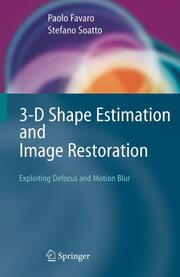Detailansicht
3-D Shape Estimation and Image Restoration
Exploiting Defocus and Motion-Blur
ISBN/EAN: 9781849965590
Umbreit-Nr.: 1525099
Sprache:
Englisch
Umfang: xiv, 249 S.
Format in cm:
Einband:
kartoniertes Buch
Erschienen am 18.02.2013
Auflage: 1/2014
- Zusatztext
- InhaltsangabeBasic models of image formation.- Some analysis: When can 3-D shape be reconstructed from blurred images?.- Least-squares shape from defocus.- Enforcing positivity: Shape from defocus and image restoration by minimizing I-divergence.- Defocus via diffusion: Modeling and reconstruction.- Dealing with motion: Unifying defocus and motion blur.- Dealing with multiple moving objects.- Dealing with occlusions.- Final remarks.
- Kurztext
- Images contain information about the spatial properties of the scene they depict. When coupled with suitable assumptions, images can be used to infer three-dimensional information. This useful volume concentrates on motion blur and defocus, which can be exploited to infer the 3-D structure of a scene-as well as its radiance properties-and which in turn can be used to generate novel images with better quality. 3D Shape Estimation and Image Restoration presents a coherent framework for the analysis and design of algorithms to estimate 3D shape from defocused and motion blurred images, and to eliminate defocus and motion blur to yield "restored" images. It provides a collection of algorithms that are optimal with respect to the chosen model and estimation criterion. Topics and Features include: Comprehensive introduction to guide readers through the different areas of the topic Basic models of image formation Discussion of leastsquares shape from defocus Unifying defocus and motion blur Handling multiple moving objects Dealing with occlusions Appendices supply the necessary background in optimization and regularization www.eps.hw.ac.uk/~pf21/FavaroSoattoBook/downloads contains implementations of relevant algorithms, test data and demos. Written for readers with interests in image processing and computer vision and with backgrounds in engineering, science or mathematics, this highly practical text/reference is accessible to advanced students or those with a degree that includes basic linear algebra and calculus courses. It can also be seen as a resource for practitioners looking to expand their knowledge in the subject.
- Autorenportrait
- InhaltsangabeVisual Cues for Shape and Motion.- Basic Models of Image Formation.- When Can 3D Shape Be Reconstructed from Blurred Images?- A First Solution: Least-Squares.- Enforcing Positivity.- Defocus via Diffusion: Modeling and Reconstruction from Two Views.- Shape from the Defocus of Multiple Images.- Modeling Motion-Blur and Defocus via Diffusion.- Dealing with Occlusions.- Conclusions and Open Issues.- Appendixes: Concepts of Radiometry.- A PDE Primer.- Proofs of Propositions.- Calibration of Defocused Images.- Matlab Implementation of Some Algorithms.- Index.
